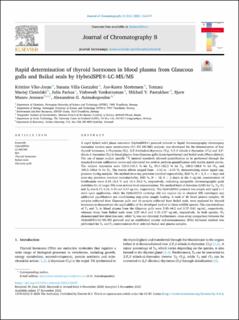| dc.description.abstract | A rapid hybrid solid phase extraction (HybridSPE®) protocol tailored to liquid chromatography–electrospray ionization tandem mass spectrometry (LC–ESI–MS/MS) analysis, was developed for the determination of four thyroid hormones, L-Thyroxine (T4), 3,3′,5-triiodo-L-thyronine (T3), 3,3′,5′-triiodo-L-thyronine (rT3) and 3,3′-diiodo-L-thyronine (T2) in blood plasma from Glaucous gulls (Larus hyperboreus) and Baikal seals (Phoca sibirica). The use of target analyte specific 13C internal standards allowed quantification to be performed through the standard solvent calibration curves and alleviated the need to perform quantification with matrix match curves. The relative recoveries were 100.0–110.1 % for T4, 99.1–102.2 % for T3, 100.5–108.0 % for rT3, and 100.5–104.6 % for T2. The matrix effects ranged from −1.52 to −6.10 %, demonstrating minor signal suppression during analysis. The method intra-day precision (method repeatability, RSD %, N = 5, k = 1 day) and inter-day precision (method reproducibility, RSD %, N = 10, k = 2 days) at the 1 ng/mL concentration of fortification were 8.54–15.4 % and 15.4–24.8 %, respectively, indicating acceptable chromatographic peak stabilities for all target THs even at trace level concentrations. The method limit of detection (LOD) for T4, T3, rT3 and T2 was 0.17, 0.16, 0.30 and 0.17 ng/mL, respectively. The HybridSPE® protocol was simple and rapid (<1 min) upon application, while the HybridSPE® cartridge did not require (as in classical SPE cartridges) any additional equilibration nor conditioning step prior sample loading. A total of 46 blood plasma samples, 30 samples collected from Glaucous gulls and 16 samples collected from Baikal seals, were analyzed for thyroid hormones to demonstrate the applicability of the developed method in these wildlife species. The concentrations of T4 and T3 in blood plasma from the Glaucous gulls were 5.95–44.2 and 0.37–5.61 ng/mL, respectively, whereas those from Baikal seals were 3.57–46.5 and 0.45–2.07 ng/mL, respectively. In both species, rT3 demonstrated low detection rate, while T2 was not detected. Furthermore, cross-array comparison between the HybridSPE®-LC-MS/MS protocol and an established routine radioimmunoassay (RIA) kit-based method was performed for T4 and T3 concentrations from selected Baikal seal plasma samples. | en_US |

